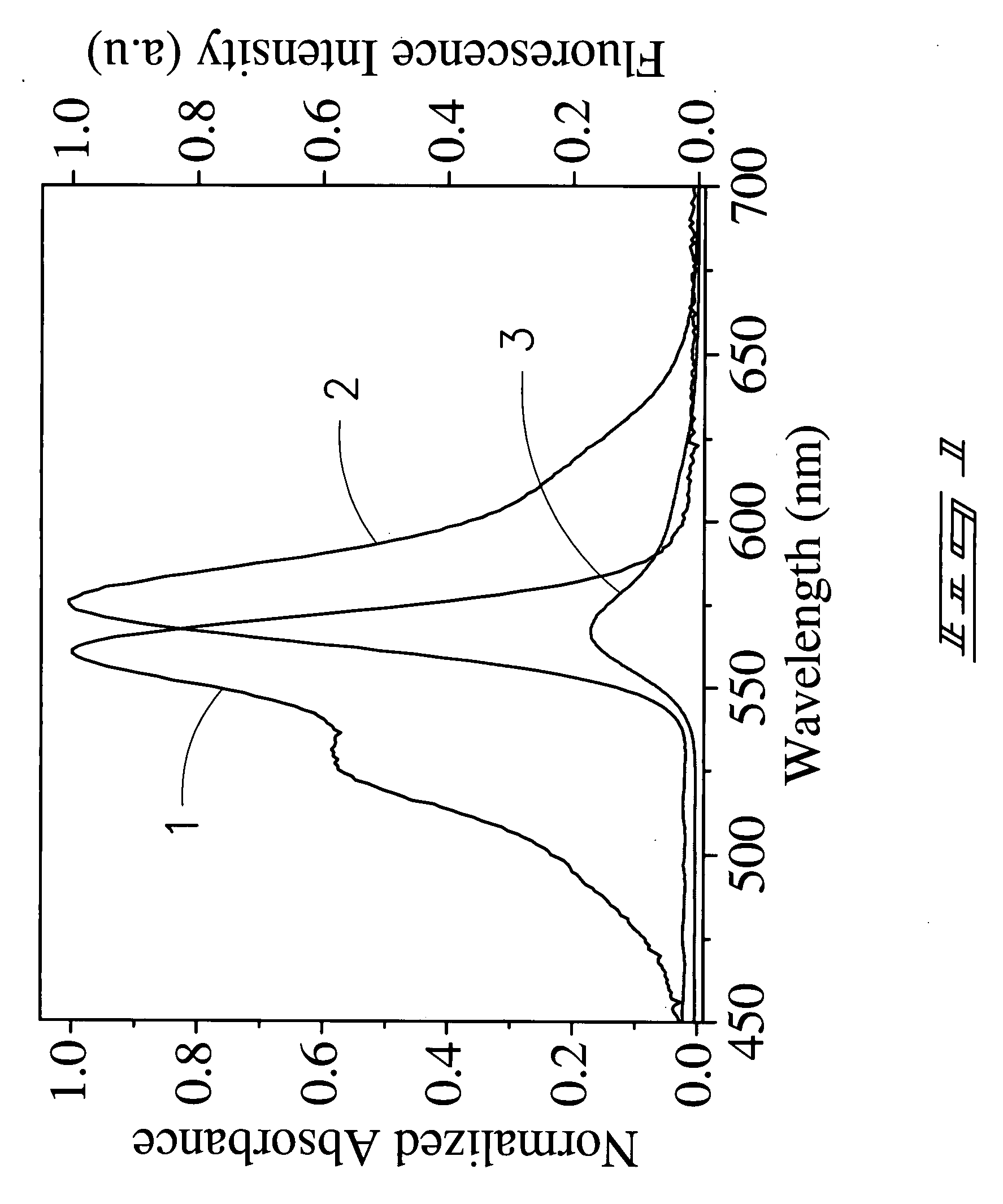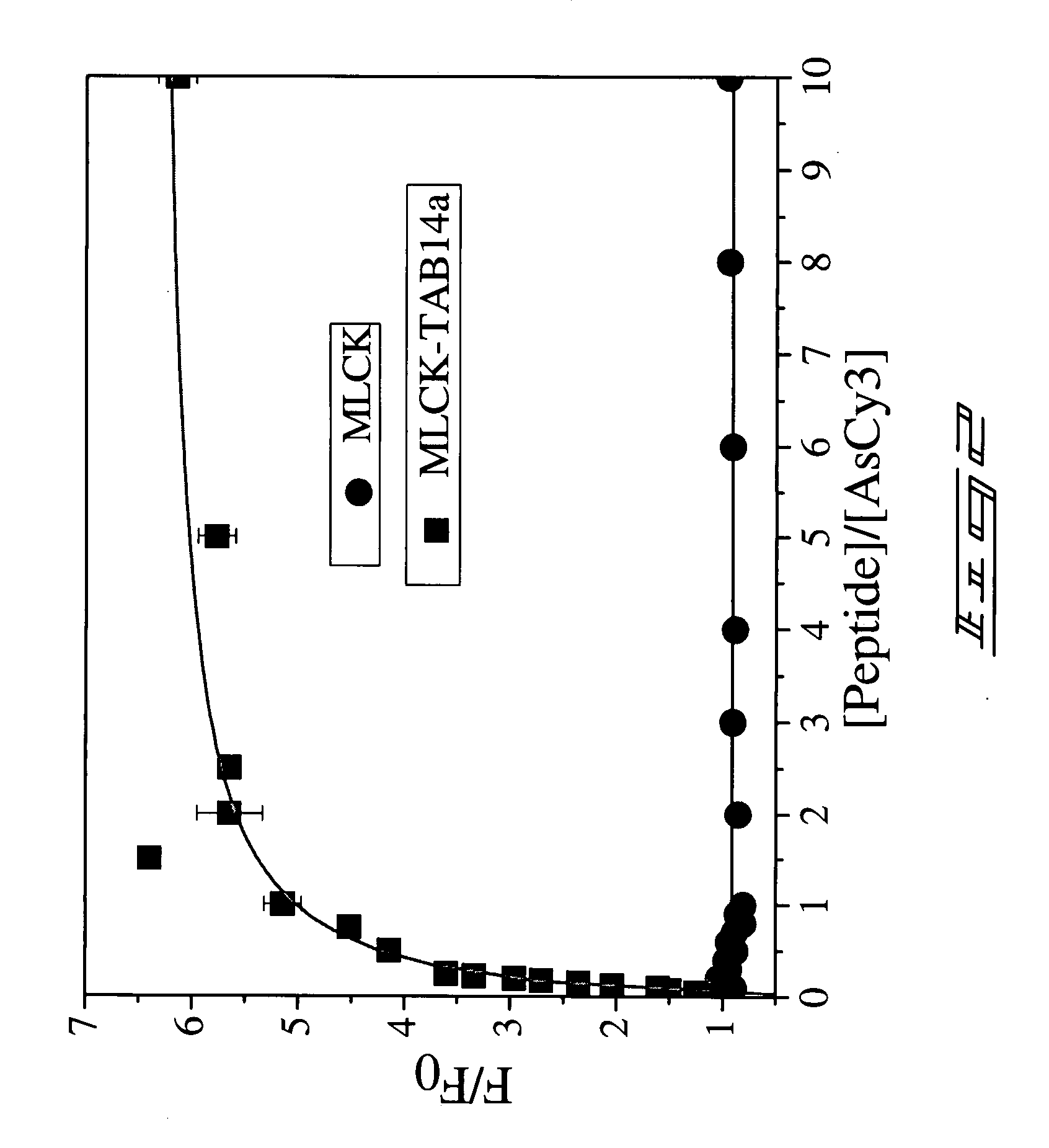A Cyanine-based probe\tag-peptide pair for fluorescence protein imaging and fluorescence protein imaging methods
a technology of fluorescence protein and tag peptide, which is applied in the direction of peptide/protein ingredients, peptide sources, molecular probes, etc., can solve the problems of inability to perform two color experiments utilizing such equidistant probes, and inability to accurately detect the tag protein or biophysical measurements
- Summary
- Abstract
- Description
- Claims
- Application Information
AI Technical Summary
Problems solved by technology
Method used
Image
Examples
example 1
2-((1E,3E)-3-(7-(1,3,2-dithiarsolan-2-yl)-1,1,3-trimethyl-1H-benzo [e]indol-2(3H)-ylidene)prop-1-enyl)-7-(1,3,2-dithiarsolan-2-yl)-1,1,3-trimethyl-1H-benzo[e]indolium
[0047]
[0048]A: A mixture of 2,3,3-trimethyl-indole (0.80 g, 5 mmol) and 1,4-butane sultone (2.25 g, 16 mmol) in 7 mL of 1,2-dichlorobenzene was refluxed at 120° C. for 12 hr under an Argon atmosphere. After cooling, the reaction mixture was dropped into cold acetone (100 mL) and the precipitate was collected. 1-δ-Sulfobutyl-2,3,3-trimethyl-indolenine (pink powder) was washed with acetone (20 mL) three times. The yield was 69%.
[0049]B: The compound from Step A (296 mg, 1 mmol, 1 eq.) and N,N′-(propane-1,3-diylidene)dianiline hydrochloride (259 mg, 1 mmol, 1 eq.) were heated together in a buffered acetic anhydride / acetic acid mixture (1.5 mL acetic acid, 1.13 mL acetic anhydride and 0.065 g sodium acetate) at 120° C. for 12 hrs. After the reaction, the solvent was removed and the residue was dissolved in MeOH. 2-(5-(3,3-d...
example 2
2-((1E,3E)-3-(7-(1,3,2-dithiarsolan-2-yl)-1,1,3-trimethyl-1H-benzo[e]indol-2(3H)-ylidene)prop-1-enyl)-7-(1,3,2-dithiarsolan-2-yl)-1,1,3-trimethyl-1H-benzo[e]indolium
[0051]
[0052]A: A mixture of 2,3,3-trimethyl-indole (5 g, 24 mmol) and methyl iodide (6.79 g, 48 mmol) in 50 mL of acetonitrile was refluxed at 120° C. for 30 min under a Argon atmosphere. After cooling, the product precipitated and was collected from solution. 1,1,2,3-tetramethyl-1H-benzo[e]indolium (white powder) was recrystallized using ethanol (20 mL) three times, yield 80%.
[0053]B: The compound from Step A (2 g, 9 mmol, 1 eq.) and triethyl orthoformate (2.64 g, 18 mmol, 2 eq.) were heated to refluxing in pyridine for 9 hrs. After the reaction, the solvent was removed and the residue was dissolved in MeOH. Product was purified by silica gel TLC (ethyl acetate: MeOH=2:1 v / v) with 73% yield.
[0054]C: The compound from Step B (43 mg, 0.08 mmol, 1 eq.) was added into trifluoroacetic acid (3 mL) containing mercuric oxide (9...
example 3
2-((1E,3E,5E,7E)-7-(5-(1,3,2-dithiarsolan-2-yl)-1,3,3-trimethylindolin-2-ylidene)hepta-1,3,5-trienyl)-5-(1,3,2-dithiarsolan-2-yl)-1,3,3-trimethyl-3H-indolium
[0055]
[0056]1,3,3-trimethyl-2-((1E,3E,5E,7E)-7-(1,3,3-trimethylindolin-2-ylidene)hepta-1,3,5-trienyl)-3H-indolium (200 mg, 0.4 mmol, 1 eq.) was added into trifluoroacetic acid (5 mL) containing mercuric oxide (201 mg, 1 mmol, 2.5 eq.) at room temperature. After overnight stirring, the reaction mixture was evaporated. Red precipitate (Ay7-bis-mercuric trifluoroacetate, 300 mg) was collected by filtration with 75% yield. After drying in high vacuum, Cy7-bis-mercuric trifluoroacetate (100 mg) was suspended in dry N-methylpyrrolidinone (1.5 mL) with arsenic trichloride (100 uL, 2.0 mmol, 20 eq.), diisopropyl ethyl amine (83 uL, 0.8 mmol, 8 eq.) and catalytic palladium acetate (30 mg). The reaction was stirred at room temperature for 8 hours. After reaction, 10 mL 0.25M phosphate buffer pH 7 and 1,2-ethanedithiol (0.4 mL, 40 eq.) wer...
PUM
| Property | Measurement | Unit |
|---|---|---|
| Distance | aaaaa | aaaaa |
| Energy | aaaaa | aaaaa |
| Fluorescence | aaaaa | aaaaa |
Abstract
Description
Claims
Application Information
 Login to View More
Login to View More - R&D
- Intellectual Property
- Life Sciences
- Materials
- Tech Scout
- Unparalleled Data Quality
- Higher Quality Content
- 60% Fewer Hallucinations
Browse by: Latest US Patents, China's latest patents, Technical Efficacy Thesaurus, Application Domain, Technology Topic, Popular Technical Reports.
© 2025 PatSnap. All rights reserved.Legal|Privacy policy|Modern Slavery Act Transparency Statement|Sitemap|About US| Contact US: help@patsnap.com



